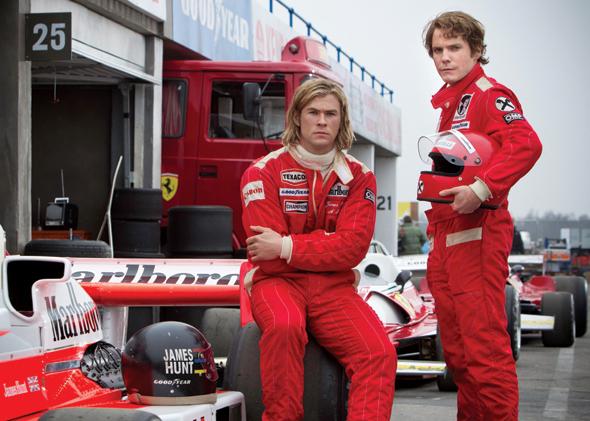The rivalry between two fiercely competitive, temperamentally opposed race-car drivers is a subject that’s had at least two memorable cinematic treatments in recent years. In the 2006 comedy Talladega Nights, Will Ferrell and Sasha Baron Cohen were hilarious as NASCAR drivers bent on each other’s destruction, while the mesmerizing 2010 documentary Senna traced the real-life competition between the Brazilian Formula One driver Ayrton Senna and his career archrival, the French driver Alain Prost. When I heard that Ron Howard was taking on similar material in straightforward dramatic form with Rush—a kind of joint biopic of ’70s Formula One stars Niki Lauda and James Hunt—I wondered if it was possible to make a movie about a death match between racing rivals without slipping into parody. But Howard (aided by screenwriter Frost/Nixon screenwriter Peter Morgan) has gone and done it: Rush is an outsize Hollywood spectacle about two outsize personalities in conflict, a sleekly assembled thrill machine that makes up in excitement for what it lacks in nuance.
Rush focuses on the years between 1970 and 1976, following its protagonists’ rise from scrappy third-string race-car jockeys to archrivals for the Formula One world championship title. Hunt (Chris Hemsworth, last seen winging a massive hammer at aliens as The Avengers’ Thor) is a Brit, a daredevil and a notorious playboy, given to toking up before big races, getting roaring drunk afterward, and nailing every attractive woman in sight (in one early scene, he beds an emergency-room nurse before she can even finish dressing his wounds). Lauda (Daniel Brühl, a Spanish-born German actor soon to be seen in The Fifth Estate) is Hunt’s polar opposite in nearly every way, a cold, technocratic Austrian whose maniacal preparation includes a precise calculation of the mathematical risk he takes with each race. Lauda refuses to go over a 20 percent chance of dying—a degree of caution which sounds more than reasonable to those of us not in the business of hurtling in circles at 170 miles per hour, but which earns him the scorn of his more macho colleagues, Hunt first among them.
From the moment they meet, Lauda and Hunt take a strong dislike to one another, but they’re also bound together by their obsessive love for speed, and for victory. At the track and at press conferences, they go out of their way to trash-talk and upstage each other: Lauda is always ready to mock Hunt’s lack of discipline and Hunt, Lauda’s rule-bound prissiness. The two men’s personal lives also exist in stark contrast: Hunt’s impulsive marriage to the model Suzy Miller (Olivia Wilde) quickly falls apart when she leaves him for Richard Burton, while Lauda’s union with the devoted Marlene (Alexandra Maria Lara) is strong enough to make him rethink his approach to risk assessment: Is a one-in-five likelihood of dying per race a chance he still wants to take?
It’s during the event-packed Grand Prix season of 1976 that the Hunt/Lauda rivalry becomes the stuff of which sports legends are made. If, like me, you know nothing of the events of that year, I won’t spoil the heart-stopping second half, except to say that the Lauda character, who in the early scenes comes off as something of a nasty prig, emerges as the movie’s unexpected moral center, and its true hero. Brühl is exceptional in his actorly restraint—given multiple opportunities to win over the audience with easy sentimental uplift, he refuses them all to create a character who’s prickly and charmless, yet oddly admirable. Hemsworth’s performance is broader—all he really has to do is turn the lion-maned golden-boy charisma up to 11 and keep it there for two hours—but he’s irresistible as the rakish Hunt.
Rush’s title is apropos, as the movie, shot by Danny Boyle’s longtime cinematographer Anthony Dod Mantle, hurtles forward at a sometimes vertiginous pace. Extreme close-ups of pumping pistons and drivers’ bloodshot eyeballs alternate with soaring aerial views of the cars Hunt calls “coffins on wheels” as they careen around the track. There’s also extensive use of a point-of-view shot from within the car that owes a lot to the helmet-mounted cameras that made Senna’s race footage so thrilling. The film’s forward rhythm is slowed only by a few unnecessary detours into overfamiliar biopic territory—do we really need to watch Hunt down an entire bottle of scotch the night after a big defeat as a phonograph needle scratches on a played-out record? This isn’t a movie that paints in fine brushstrokes, but there’s something primally satisfying about the starkness of its last, suspenseful faceoff: two rivals, two cars, one rain-drenched racetrack, and may the best man win.
